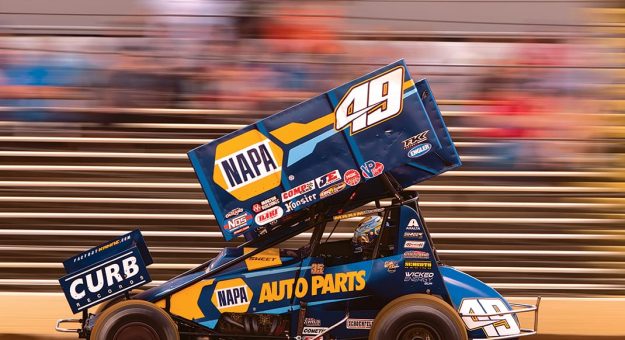Brad Sweet is a happy guy these days. He’s fresh off a World of Outlaws championship and enjoying life with his wife Rachel and young daughter Savannah.
Brad Sweet is a happy guy these days. He‘s fresh off a World of Outlaws championship and enjoying life with his wife Rachel and young daughter Savannah at their home in his native California.
His is the quintessential story of the underdog, raised on a 10-acre spread in Grass Valley, Calif., an hour northeast of Sacramento, and helped his family to raise pigs as a youth.
After starting his racing career in outlaw karts at the age of eight, then moving to mini-sprints, and then sprint cars at age 15, he yearned to make the long move to the Indianapolis area to take his shot at a full-time racing career.
So, in 2005 he loaded his sprint car onto an open trailer hitched to his 15-year-old pickup truck and, with very little belongings along for the ride, he and friend Darin “Heavy D” Smith towed east.
Once there, the low-buck racer began the climb, working hard and weathering the ups and downs of the racing landscape before eventually reaching the summit: a World of Outlaws championship.
We took some time out with Brad to discuss his racing journey so far.
SC&M: You‘re now a World of Outlaws champion, and you‘ve won an impressive amount of big races. Looking back, what was your goal when you climbed into that pickup truck in 2005 and headed east to Indiana?

BRAD SWEET: Honestly, back then it was just to try to make a living racing. I didn‘t really know what that meant. Obviously, I had dreams to make it to NASCAR like every other little kid but, really, once I got there and started racing, I just wanted to be able to keep doing it. I wanted to do it for a living. You know, I wanted that to be my job. I didn‘t want to, basically, be a weekend racer or, you know, I didn‘t want to have to go have a real job and not be able to race at all.
1 So, I would say at this point, yeah, it‘s probably exceeded my expectations and obviously I dreamed about all that stuff, but you have to be realistic. So, I had some very fortunate breaks and just capitalized on some good situations that I‘ve gotten myself into and have been lucky enough to get all those wins and get to the point that I‘m at in my career.
SC&M: You were 19 at that time, right?
SWEET: Nineteen, yeah. I graduated high school and then that next summer took off.
SC&M: When you towed out, you brought your own car and raced a lot in that car but, even though you didn‘t get a steady ride, you did seem to get some opportunities to drive for other car owners fairly quickly once you hit Indiana.
SWEET: Yeah, that‘s one of the things that always intrigued me about Indiana, was there‘s just so much racing, and so many different car owners. For a guy like me there was a lot of opportunity there — for someone who doesn‘t have much money. You know, we used our car as a tool, basically, just to try to get my name out there, and then basically once we were able to show people that we could drive — we didn‘t really have the money to necessarily run that car here, so I would take rides. I think I drove for six or eight different car owners that first year.
I was just learning, so I tore up some cars and struggled kinda through that season, but it was definitely a big learning year for me, for sure.
SC&M: And, part of that learning curve that year was the night you flipped over the fence at Haubstadt.
SWEET: That was that year, in the family car; the car that we took out there. Believe it or not, we still raced it a little bit even after that. But, yeah, that was that year.
To continue reading, advance to the next page.
